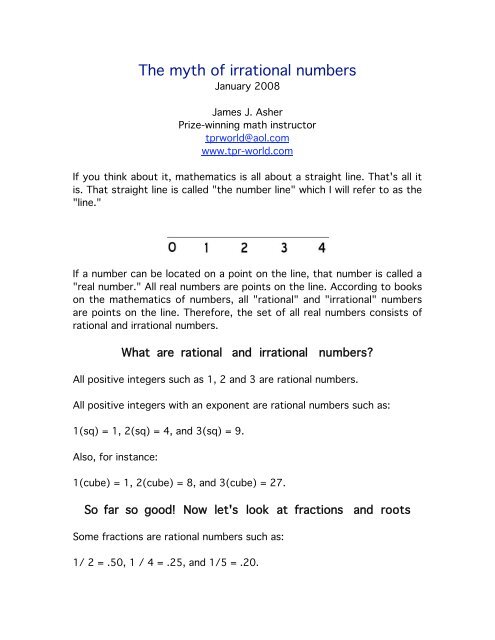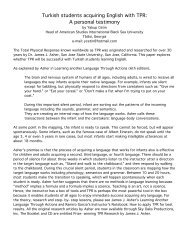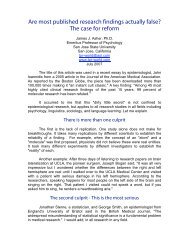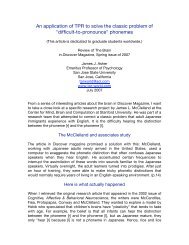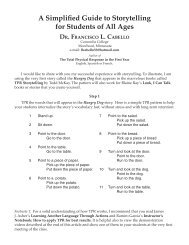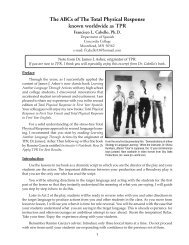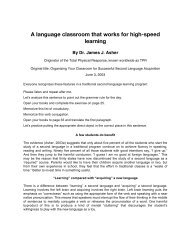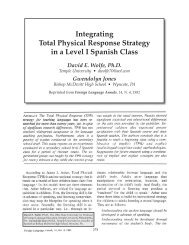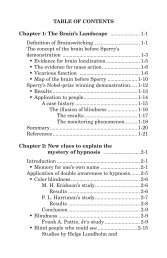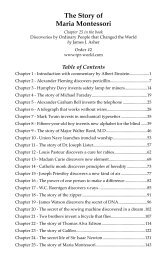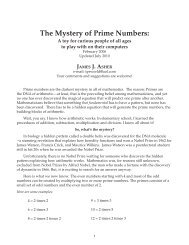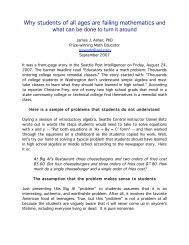The myth of irrational numbers - TPR World
The myth of irrational numbers - TPR World
The myth of irrational numbers - TPR World
You also want an ePaper? Increase the reach of your titles
YUMPU automatically turns print PDFs into web optimized ePapers that Google loves.
<strong>The</strong> <strong>myth</strong> <strong>of</strong> <strong>irrational</strong> <strong>numbers</strong><br />
January 2008<br />
James J. Asher<br />
Prize-winning math instructor<br />
tprworld@aol.com<br />
www.tpr-world.com<br />
If you think about it, mathematics is all about a straight line. That's all it<br />
is. That straight line is called "the number line" which I will refer to as the<br />
"line."<br />
If a number can be located on a point on the line, that number is called a<br />
"real number." All real <strong>numbers</strong> are points on the line. According to books<br />
on the mathematics <strong>of</strong> <strong>numbers</strong>, all "rational" and "<strong>irrational</strong>" <strong>numbers</strong><br />
are points on the line. <strong>The</strong>refore, the set <strong>of</strong> all real <strong>numbers</strong> consists <strong>of</strong><br />
rational and <strong>irrational</strong> <strong>numbers</strong>.<br />
What are rational and <strong>irrational</strong> <strong>numbers</strong>?<br />
All positive integers such as 1, 2 and 3 are rational <strong>numbers</strong>.<br />
All positive integers with an exponent are rational <strong>numbers</strong> such as:<br />
1(sq) = 1, 2(sq) = 4, and 3(sq) = 9.<br />
Also, for instance:<br />
1(cube) = 1, 2(cube) = 8, and 3(cube) = 27.<br />
So far so good! Now let's look at fractions and roots<br />
Some fractions are rational <strong>numbers</strong> such as:<br />
1/ 2 = .50, 1 / 4 = .25, and 1/5 = .20.
Some roots are rational such as:<br />
(sq rt) 4 = 2, (sq rt) 9 = 3, and (sq rt) 16 = 4.<br />
It is easy to find these rationals on the line<br />
Now for the fun part <strong>of</strong> the puzzle: <strong>The</strong> <strong>irrational</strong>s<br />
Any number that ends in a decimal that continues forever is called<br />
"<strong>irrational</strong>." <strong>The</strong> mathematics books on <strong>numbers</strong> claim that <strong>irrational</strong>s can<br />
also be located on the line and hence are in the set <strong>of</strong> real <strong>numbers</strong>. I<br />
don't think this is true. I will tell you why.<br />
But first, here are come examples <strong>of</strong> <strong>irrational</strong>s:<br />
Some fractions are <strong>irrational</strong>. Examples would be:<br />
1/3 = .333..., 1/6 = .1666..., 1/7 = .1428571...<br />
Some roots are <strong>irrational</strong>. Examples would be:<br />
(sq rt) 2 = 1.4142135..., (sq rt) 3 = 1.7320508..., and (sq rt) 5 =<br />
2.2360679...<br />
I don't think <strong>irrational</strong> are on the line because<br />
<strong>irrational</strong> are not <strong>numbers</strong><br />
I know this sounds like heresy. <strong>The</strong> mathematics books refer to <strong>irrational</strong>s<br />
as "<strong>irrational</strong> <strong>numbers</strong>." I think that is the <strong>myth</strong>. I think that <strong>irrational</strong>s are<br />
non-<strong>numbers</strong>. Irrationals are becoming <strong>numbers</strong> but they will never, for all<br />
<strong>of</strong> eternity, be <strong>numbers</strong>. Think about this: (s rt) 2 = 1.4142135... and the<br />
integers continue on forever approaching some value but never ever<br />
reaching it. Since (sq rt) 2 will never be a number because it is in<br />
continual motion moving towards some number, it is a non-number. Since
it is a non-number, it cannot be located on the number line. I conclude<br />
then that only rational <strong>numbers</strong> have a location on the line and hence only<br />
rational <strong>numbers</strong> are real <strong>numbers</strong>.<br />
Here is the puzzle<br />
Consider this: Some fractions are <strong>irrational</strong>. Examples would be:<br />
1/3 = .333..., 1/6 = .1666..., 1/7 = .1428571...<br />
Since .333..., .1666..., and .1428571... continue forever without<br />
stopping, they are non-<strong>numbers</strong> which means they are not in the set <strong>of</strong><br />
real <strong>numbers</strong>, and hence cannot be located on the line. But there is a<br />
contradiction since 1/3, 1/6. And 1/7 can indeed be located on the line<br />
like this:<br />
If 1/3 means to divide the line into three parts, then 1/3 represents<br />
three points on the line:<br />
<strong>The</strong> puzzle is this: If we apply long division, 1/3 is <strong>irrational</strong> since it<br />
results in .333...and hence is a non-number and therefore cannot be<br />
located with a single point on the line. However, if 1/3 represents<br />
cutting the line or any unit on the line into three pieces or parts, then 1/3<br />
is indeed located on the line. This suggests that 1/3 has two different<br />
meanings, but what is it?<br />
Another famous example may help clarify<br />
<strong>The</strong> Pythagorean theorem allows us to find the diagonal <strong>of</strong> any rectangle<br />
(and remember that a square is a rectangle) with this famous equation:<br />
a(sq) + b(sq) = c(sq).<br />
a and b are the length and width <strong>of</strong> the rectangle and the square root <strong>of</strong><br />
c is the length <strong>of</strong> the diagonal. Obviously, the diagonal is a finite<br />
measurement like this:
Applying the Pythagorean theorem, 1(sq) + 1(sq) = 2 and the square<br />
root <strong>of</strong> 2 is an <strong>irrational</strong> <strong>of</strong> 1.4142135... which is a non-number. But, how<br />
can this be since we can measure the diagonal's length with a ruler and<br />
get a definite answer? <strong>The</strong> length <strong>of</strong> the diagonal is not becoming a<br />
number; it has an exact beginning and an exact ending point on the ruler.<br />
<strong>The</strong> mystery can be solved<br />
by looking at the nature <strong>of</strong> long division<br />
Most <strong>of</strong> us acquired long division by rote, that is, by following a step-bystep<br />
recipe until the procedure was automatic. We assume it is a valid<br />
procedure, but is it?<br />
Let's set up 1/3 with long division:<br />
<strong>The</strong> set up tells us to divide 3 into 1, but we are told that we cannot do<br />
this. Why not? Because 3 does not go into 1. But if I have one inch on a<br />
ruler, for example, I can divide it into three parts. So 3 does go into one if<br />
one means the length <strong>of</strong> a unit. I cannot divide 3 into if one means a point<br />
on the line because a point is the smallest indivisible thing on earth. A<br />
point cannot be divided.<br />
So far, it all makes some sense. Since I cannot divide 3 into 1, which is a<br />
point on the line, I am told to put a period after the 1 and add a zero like<br />
this:<br />
Now instead <strong>of</strong> trying to divide a point labeled 1 on the line, I have a<br />
length <strong>of</strong> 10 to work with. <strong>The</strong> problem here, as I see it, is we have<br />
switched from a scale consisting <strong>of</strong> points on the line to a scale with<br />
lengths on the line. This may be the same flaw as mixing apples and<br />
oranges in arithmetic. For example, 2 apples + 2 oranges = ? We might<br />
say 4 pieces <strong>of</strong> fruit but this answer is wildly ambiguous since we could<br />
have 1 apple and 3 oranges, 3 apples and 1 orange or 4 pieces <strong>of</strong><br />
pineapple, or any combination <strong>of</strong> fruit.
<strong>The</strong> length on the line is now 10 and we sort the 10 units into three sets<br />
<strong>of</strong> three with one unit remaining like this:<br />
Now, what are we going to do with the remainder? Well, the recipe calls<br />
for adding another zero like this:<br />
So the length on the line is 10, like this:<br />
This continues forever because there will always be another remainder <strong>of</strong><br />
1. <strong>The</strong> fallacy is that we started with the task <strong>of</strong> dividing 3 into a point on<br />
the line labeled 1. <strong>The</strong> point could have been labeled anything. We could<br />
have called it James or Mary. It is still a point and a point is indivisible.<br />
Hence, the instructor is exactly right is saying, "Under these<br />
circumstances, we cannot divide 3 into 1." If we conceptualized 1 as a<br />
length rather than a point, then <strong>of</strong> course we can divide 3 into 1 to get<br />
three parts.<br />
<strong>The</strong> first step in long division is fine (i.e., 3/1 =?). <strong>The</strong> next step however,<br />
is questionable. That is, changing the scale from points on the line to<br />
lengths on the line. I think that this is where <strong>irrational</strong>s are manufactured<br />
creating the <strong>myth</strong> that the <strong>irrational</strong>s are actually <strong>numbers</strong>. <strong>The</strong>y are not.<br />
<strong>The</strong>y are artifacts <strong>of</strong> a flaw in long division. <strong>The</strong>y are a "red herring" to<br />
use a metaphor from Sherlock Homes. <strong>The</strong>y led us on a merry chase<br />
through volumes <strong>of</strong> math books. <strong>The</strong> <strong>irrational</strong>s are not in the set <strong>of</strong> real<br />
<strong>numbers</strong>.<br />
Conclusion<br />
I think Pythagoras, Euclid, Descartes, Newton, and Einstein were on target<br />
with their concept <strong>of</strong> a universe with simple, elegant, symmetrical<br />
patterns <strong>of</strong> rational <strong>numbers</strong> that decode the blueprint <strong>of</strong> nature.<br />
European mathematicians <strong>of</strong> the 17-century were attracted to intricate<br />
models inspired by the mechanical age <strong>of</strong> more and more complex
machines. Hence, they were smitten with mathematical models that were<br />
more and more complicated. <strong>The</strong> more complex, the closer they felt they<br />
were to reality.<br />
R E F E R E N C E S<br />
To order James Asher’s books online, go to www.tpr-world.com<br />
<br />
Asher, James J. Learning Another Language Through Actions (6th<br />
edition).<br />
Los Gatos, CA., Sky Oaks Productions, Inc.<br />
<br />
Asher, James J. Brainswitching: Learning on the right side <strong>of</strong> the brain.<br />
Los Gatos, CA., Sky Oaks Productions, Inc.<br />
<br />
Asher, James J. <strong>The</strong> Super School: Teaching on the right side <strong>of</strong> the brain.<br />
Los Gatos, CA., Sky Oaks Productions, Inc.<br />
<br />
Asher, James J. <strong>The</strong> Weird and Wonderful <strong>World</strong> <strong>of</strong> Mathematical<br />
Mysteries: Conversations with famous scientists and mathematicians.<br />
Los Gatos, CA., Sky Oaks Productions, Inc.<br />
Asher, James J. A Simplified Guide to Statistics for Non-Mathematicians.<br />
Los Gatos, CA., Sky Oaks Productions, Inc.<br />
<br />
Asher, James J. Prize-winning <strong>TPR</strong> Research (Booklet and CD).<br />
Los Gatos, CA., Sky Oaks


